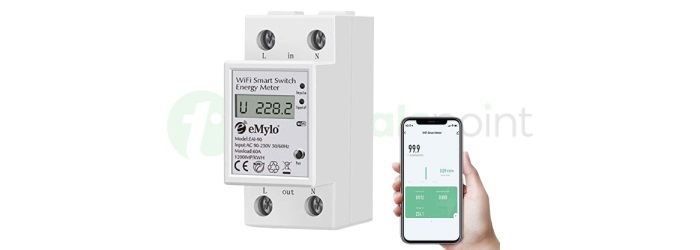
 Data Structure
Data Structure Networking
Networking RDBMS
RDBMS Operating System
Operating System Java
Java MS Excel
MS Excel iOS
iOS HTML
HTML CSS
CSS Android
Android Python
Python C Programming
C Programming C++
C++ C#
C# MongoDB
MongoDB MySQL
MySQL Javascript
Javascript PHP
PHP
- Selected Reading
- UPSC IAS Exams Notes
- Developer's Best Practices
- Questions and Answers
- Effective Resume Writing
- HR Interview Questions
- Computer Glossary
- Who is Who
Types of Energy Meters and Their Working Principles
An energy meter is a device used for measuring the amount of electrical energy consumed by a load over a certain period of time. This device is essential for recording the electricity usages so that consumers can monitor and change the energy consumption patterns to reduce energy consumption and hence the bill amount.
An energy meter is an important link between power supplier and consumers that allows them for efficient measurement of electricity supplied or consumed.
What is an Energy Meter?
An electrical device or instrument which is used for measuring the amount of electricity consumed by the consumers over a certain period of time is called an energy meter. Since, the electrical energy is measured in watt-hour. Hence, it is also known as watt-hour meter.
The primary function of an energy meter is to monitor the electricity consumption accurately. It provides information about energy utilization patterns that helps the consumers to optimize their energy consumption and reduce the bill amount.
Types of Energy Meters
Depending on the technology, there are following three types of energy meters used in actual practices for energy measurement
Analog Energy Meter
Digital Energy Meter
Smart Energy Meter
Each of these types of energy meters have different construction and working principle. Let us discuss in detail.
Analog Energy Meter
A type of energy meter in which an electromechanical system is used for measuring electrical energy is called an analog energy meter. It is also called an electromechanical energy meter. This type of energy meter operates on the principles of electromagnetic induction.

It consists of a light weight metallic disc generally made up of aluminum. It is a placed between electromagnetic coils and go through electromagnetic induction when electricity flows through the meter. To display reading of the electricity consumed, the analog meters have a rotating dial or mechanical counter system.
Analog meters were very common in early days, but these days they are replaced by digital and smart energy meters because of the following drawbacks
Analog energy meters are less accurate.
They are not energy efficient.
Advanced features like remote monitoring, data communication, etc. cannot be implemented in analog energy meters.
Analog energy meters are larger in size.
However, the analog energy meters are still used in some special applications.
Features of Analog Energy Meters
The following are some key features and characteristics of analog energy meters
Analog energy meters provide only basic energy measurement capabilities in kWh.
Due to robust construction and mature technology, the analog energy meters are durable and require less maintenance.
Analog energy measures use a mechanical dial or counter to display the readings of energy measurement.
Analog energy meters are low-cost solutions for energy measurement.
Analog energy meters are compatible with any electrical system. Thus, they can be just installed and used.
So, this is all about analog energy meters, their working and features.
Digital Energy Meter
A type of energy meter which consists of electronic components and digital logic technologies for measuring electricity consumed by a load is called a digital energy meter.

A digital energy meter is a modern solution for more accurate measurement of electricity consumptions. In this type of energy meter, no mechanical components are used. Hence, these meters have relatively longer life span than analog energy meters.
In digital energy meters, a digital display (7-segment/LCD/LED display) is used which shows readings of energy consumption in decimal digits. Therefore, taking energy reading from these meters is very easy.
Also, digital meters provide some advanced facilities like measurement of current, voltage, power, etc. These values can be seen by pressing a button given on the meter dashboard.
Features of Digital Energy Meters
Some of the important features of digital energy meters are listed below
Digital energy meters have a digital display to show the readings of measurement. Thus, they are easy to read.
Digital energy meters are composed of highly efficient and reliable electronic components. Thus, they are more accurate in terms of measurement.
Digital energy meters can also measure additional data of electrical system such as load current, voltage, power, etc.
Digital energy meters are compatible with older electrical systems as well as modern electrical systems.
Digital energy meters provide extra layer of security through meter seals that prevents electricity theft.
These meters have no mechanical components. Hence, there is no wear and tear during operation. This significantly increases the lifespan.
This is all about digital energy meters and their characteristics. Let us now discuss about another type of energy meter called smart energy meter.
Smart Energy Meter
A type of energy meter that combines the digital energy meter technology with advanced features like remote monitoring, real-time data communication, two-way communication, and more is called a smart energy meter.

Smart energy meters are the parts of smart grid technology and advanced metering infrastructure (AMI) in electrical technology. These meters help consumers to know their energy consumption patterns more accurately. They also provide detailed reports on energy utilization to both consumers and utility companies. This is only possible because the smart energy meters are equipped with advanced features like two-way communication.
These meters can also be designed in prepaid mechanism, where the consumer has to do a recharge as per his needs and can get electricity supply. This reduces the cost and time required in billing system.
Features of Smart Energy Meters
The following are some important features and characteristics of smart energy meters that distinguish them from traditional analog and digital meters
Smart energy meters are capable of providing detailed information about energy consumption. So that consumers can manage their energy utilization pattern accordingly.
Smart energy meters support real-time two-way communication that allows for more efficient management of electrical system.
Smart energy meters are also equipped with remote monitoring system. Thus, they allow to perform operations like readings, fault diagnosis, service upgradation, etc. without visiting the consumer's site i.e., fully remotely.
Smart energy meters monitor the electrical system in real-time and thus they provide more detailed reports on energy utilization.
Smart energy meters have built-in communication system that enables consumers to know about modern energy trends.
Smart energy meters can be easily integrated with renewable resources of electricity.
Advanced security features are implemented in the smart meters that protect the consumer's data and prevent any kind of unauthorized access.
So, this is all about smart energy meters and their features.
Conclusion
In conclusion, an energy meter is an instrument used for measuring amount of electricity consumed by consumers over a certain period of time. Depending on the technology used, the energy meters can be classified into three main types namely analog energy meters, digital energy meters, and smart energy meters. We have discussed about these energy meters above in detail.
FAQs Based on Energy Meters
Some frequently asked questions related to energy meters are answered in the following section.
1. What are the applications of energy meter?
The main application of an energy meter is to measure the amount of electrical energy consumed by a load.
2. What are the advantages of energy meter?
The following are some key advantages of energy meters
Accurate measurement electricity consumed.
Provides details about electrical parameters of the system like current, voltage, power, power factor, etc.
Helps in understanding energy usage patterns.
3. How to read an energy meter?
Different types of energy meters have different reading mechanism. For example,
In analog meters, readings are taken from a dial.
In digital and smart meters, readings are taken from a digital display.
4. What is the calibration of energy meter?
The calibration of energy meter is a process of determining the errors and verifying the accuracy in energy measurement. In this process, we compare the actual readings with some standard values and do adjustments if required.
5. What is IB and IMAX in energy meter?
In an energy meter, IB is called the base current and it is defined as the rated current at which the energy meter is calibrated. It is the maximum current for which the given energy meter is designed to measure the energy consumption accurately.
On the other hand, IMAX is the maximum current. It is the amount of current that the energy meter can handle without getting damaged. An electric current beyond IMAX can cause malfunctioning or damage to the meter.

